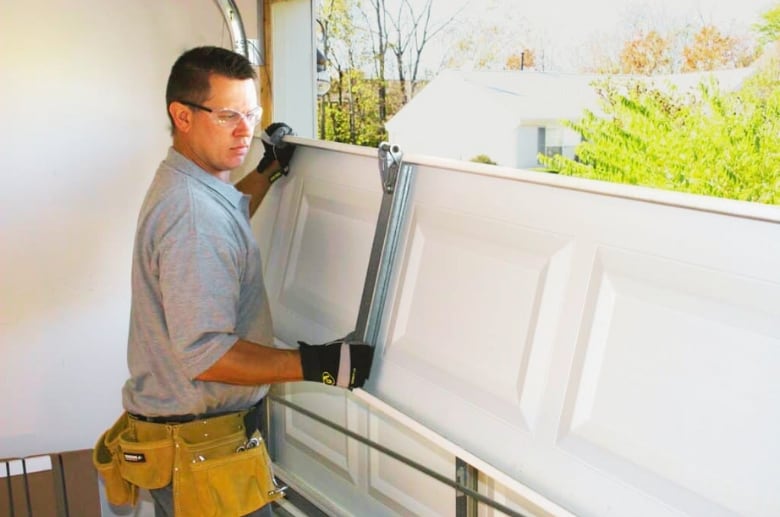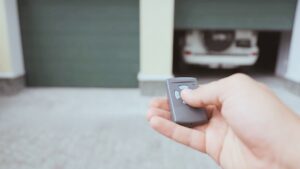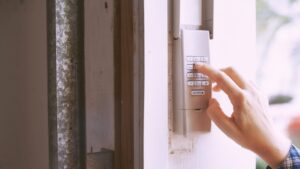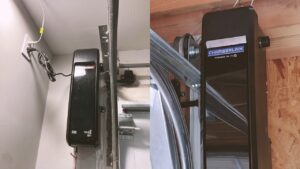Garage door springs are a vital part of ensuring the smooth operation of your garage door. However, it’s important to note that these springs can be hazardous and require careful handling to avoid injury or damage.
The primary reason garage door springs dangerous is that they are tightly wound under high tension. If they snap, they can release tremendous energy that can cause severe injury or even death.
Fortunately, you can take several safety measures to protect yourself during the spring replacement process. Our comprehensive guide outlines the steps to stay safe using garage door springs to avoid the associated risks.
Let’s get started!
Garage Door Spring Deaths Per Year
The US Consumer Product Safety Commission reports that on an annual basis, roughly 30,000 people suffer injuries due to garage door accidents. To make matters even worse, many of these devastating injuries involve innocent children.
From 1974 to 1995, at least 85 children in the United States were either killed or suffered irreversible brain damage due to unfortunate accidents involving automatic garage door openers.
Therefore, implementing regular maintenance and having the proper protective gear can assist in preventing catastrophic harm or even fatality. Adhering to a maintenance schedule guarantees that the door performs optimally and its reverse mechanisms are in perfect working order.
Connect With A Garage Expert
Connect with local experts, Compare quotes, Get the best price.
Is Replacing a Garage Door Spring Dangerous?
It can be perilous to replace a broken garage door spring. This is because every time you operate your garage door, the entire weight is moved onto its spring system.
Therefore, it’s considered highly risky for homeowners to attempt repairing the springs themselves. Allow us to elaborate more on the issue below.
Why Are Garage Door Springs Dangerous?
Garage door springs are dangerous because they are made of heavy-duty steel and contain tensioned coils. If mishandled, this can lead to the spring snapping, releasing large amounts of stored energy and potentially causing severe injury or death.
Before we dive into the hazards surrounding garage door springs, let’s first explore the two primary types and evaluate their potential for danger.
Torsion Springs

Torsion springs are the most common type used in modern garage doors. They are mounted above the garage door opening and work by twisting and coiling around a metal shaft.
With the door shut, a torsion spring is under tension, and when opened, that stored power is released, aiding in lifting. Torsion springs are deemed safer than extension springs due to their trustworthiness and precise control over them.
Extension Springs

Extension springs are integral to many garage door systems, connecting to the frame and stretching and compressing as the door lifts. Crafted from coiled metal sets with cables running along their sides, these springs provide a vital service – helping you open your garage without any trouble!
As the door is opened, the coiled spring tension grows stronger until it reaches its peak; as soon as the door closes again, all that energy bursts forth and releases. Extension springs are generally considered more dangerous than torsion springs as they are under more tension and can be more unpredictable.
Extension springs are more dangerous because they are under a lot more tension than torsion springs, which can cause them to snap unexpectedly, resulting in serious injury or death.
Torsion springs, on the other hand, are better suited for carrying the garage door’s weight and, thus, less prone to snapping without warning. Plus, torsion springs are installed above the door frame or trackway, reducing exposure to people and objects and decreasing potential harm accordingly.
That aside, here are some of the significant risks associated with garage door springs:
1. Injury

One danger that garage door springs pose when trying to replace or repair them is a serious injury. The spring contains a lot of potential energy, and if it is mishandled, the garage door could unexpectedly open or close.
It’s critical also to recognize that the force stored in a garage door spring has incredible strength and can be hazardous. These springs can produce severe injuries, such as fractured bones or amputated fingers if mishandled.
If a winding bar slips, it can even shoot out at a high velocity, like a bullet. It’s crucial to approach garage door spring repair or replacement cautiously and take appropriate safety measures to minimize the risk of accidents or injuries.
2. Death
Shockingly, the National Electronic Injury Surveillance System (NEISS) reports that roughly 2,000 individuals are crushed by garage doors every year.
Here’s why this happens. Garage door springs are notoriously difficult to tinker with and can be extremely hazardous if mishandled. This is because when a spring is stretched, it has amassed an incredible amount of energy, which will abruptly detach from the cable should it snap.
This force has been known to cause severe damage or even death. Extreme caution must be exercised when handling these powerful mechanisms to avoid any potential risk.
Attempting to repair or replace garage door springs alone is not worth the risk, as it can be hazardous. It is best to leave any repairs or replacements to a trained professional with the experience and equipment to handle the job safely.
3. Installing the Wrong Spring Type
DIY projects can sometimes be messy. And when it comes to garage door springs, you must get the correct type of spring for your specific model and make.
Otherwise, you could be in a dangerous situation if you use the wrong size or type of spring when replacing the springs. This could lead to a hazardous situation where the spring is either too weak or too strong, resulting in more damage and potential injury.
4. Poor Installation
When you poorly install a garage door spring, it could result in a dangerous situation. This can occur if the wrong torque is used or the spring needs to be adequately secured to the cables and tracks.
When this happens, it will likely cause the entire system to malfunction, leading to possible injuries and damage.
5. Cement Chipping

Generally speaking, a single-car garage door can weigh anywhere from 100 to 250 pounds, while a double-car garage door can weigh between 200 and 450 pounds.
Some larger and heavier garage doors can weigh up to 1,000 pounds. That said, the impact of a garage door hitting the floor can cause more damage than chipping the cement. The force of the impact can cause significant structural damage to your garage, leading to costly repairs.
Imagine this scenario: You hit the button to close your garage door, but one of the springs suddenly breaks as it begins to close. This causes the door to come crashing down, hitting the floor with a loud thud. The force of the impact is so great that it bounces back up, hitting your car parked in the driveway. The damage to your car is extensive, but that’s not the worst.
Your loved ones, such as your children or pets, could have been playing nearby when the garage door crashed. The impact can cause severe injury or even death, depending on the impact’s force and your loved ones’ proximity. This truly terrifying scenario could happen if you do not take the necessary precautions regarding garage door safety.
How to Avoid Garage Door Spring Injury?
The dangers of garage door springs are now more visible than ever, and you understand their implications. Because we’d hate to see you going through such troubles, we detail how to avoid garage door spring injuries below.
1. Ensure the Springs Are the Correct Type
Knowing the correct type of garage door spring to install is critical. Here are a few handy tips you can use to make sure you get it right:
- Check the user manual or contact the manufacturer: Identifying the appropriate spring type for your garage door is as easy as consulting the product manual or contacting the manufacturer if you do not have one. Finding this information will ensure that you select a compatible component for your system’s safe and efficient operation.
- Measure the existing spring: If you already have a spring installed, you can measure the length and diameter of the spring to ensure that you get the correct replacement. It is crucial to measure accurately to ensure that the new spring fits appropriately.
- Consult a professional: If you’re unsure about the correct spring for your garage door or how to measure the existing one, it’s always wise to get expert advice. A professional can provide all of the information and guidance needed so that you make a well-informed decision when selecting your new spring.
- Consider the weight of your garage door: It is essential to consider the weight of your garage door when selecting an appropriate spring – if it doesn’t possess enough power, it may not be able to bear the load. An insufficiently strong spring can cause imbalance and harm, so don’t take any chances!
- Do not mix and match spring types: Ensuring a balanced garage door is essential, and using the same type of spring on both sides is imperative. If you don’t, your door could become dangerously unbalanced—not something any homeowner wants!
2. Seek Professional Assistance for Maintenance

We know. DIY projects can be fun and can also save money. But it’s best to consult a professional technician for complex repairs and maintenance involving garage door springs. This should not be a bargain because you’re considering your family’s and your safety.
Professional technicians can inspect your garage door springs system, identify potential safety hazards and address them before they become a danger to your family.
Although others may think they can complete this task independently, enlisting an expert for assistance will guarantee you’ll be safe and secure with your new system.
Connect With A Garage Expert
Connect with local experts, Compare quotes, Get the best price.
3. Check for Signs of Wear and Tear
Regularly examining your garage door springs’ condition is essential to prevent serious spring injuries. Ensure you look for any signs of damage, such as:
- Difficulty opening or closing: If your garage door struggles to open or close, it may be a sign of worn-out or damaged springs.
- Visible damage: Inspect the springs for visible signs of damage, such as dents, rust, or lose bolts
- Uneven movement: If one side of the garage door appears to be moving at a different pace or higher level than the other, it may indicate that one of the springs is damaged or worn out.
- Unusual squeaking or grinding noises: Unusual noises, such as squeaking or grinding, coming from your garage door when it operates may indicate that the springs are nearing the end of their lifespan.
- Lifecycle: Most garage door springs have a lifespan of around 7000- 10,000 cycles, which can translate to several years of use. It may be time for a replacement if your springs have reached this point or more.
Suppose you notice any of these telltale signs. In that case, it’s essential to address the issue immediately and call an expert garage door repair service to prevent further damage or potential safety hazards.
It’s also essential to hire a professional garage door technician annually to perform regular maintenance on your garage door system, including inspecting and adjusting the springs as needed.
Attempting to repair or replace garage door springs yourself can be extremely dangerous and should be avoided at all costs!
4. Educate Your Family Members
Teach your family members, especially children, about the dangers of garage door springs. Ensure all family members understand the danger garage door springs can pose and that they should never attempt to repair or replace them.
Remind family members not to try to force a garage door open if it’s stuck, as doing so can cause the garage door springs to become overloaded with tension and break. Additionally, teach your children not to play near the garage door, as spring-related injuries can be severe.
Taking all the measures above now to safeguard against garage door spring injuries is crucial in preventing dangerous and costly accidents in the future.
Is It Safe to Open a Garage Door With a Broken Spring?
If you attempt to open your garage door with broken springs, it can put a significant strain on your garage door opener, which may cause it to malfunction or even fail.
Garage door openers are designed to work with the springs to lift and lower the door smoothly. When the springs are broken, the opener may have to work much harder to lift the door’s weight, which can cause it to overheat, burn out, or damage its components over time.
In some cases, attempting to use the opener with broken springs can also cause damage to the garage door itself. Without the support of the springs, the door can become unbalanced or crooked, causing it to bind, scrape or even fall off the tracks. This can result in costly repairs or even the need for a complete garage door replacement.
Final Thoughts
Garage door spring dangers should not be taken lightly. Although it may seem minor, old or malfunctioning springs can lead to severe problems, such as irreversible injuries and fatalities!
You should periodically inspect your garage door springs for any signs of wear and tear and contact a professional if they need repair. Following the steps outlined in this guide will ensure your safety when handling garage door spring components.




